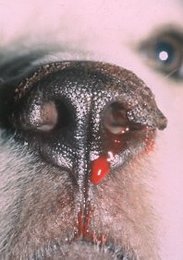
Nose Bleed
A nosebleed (epistaxis) is bleeding or haemorrhage from the nose. It is important to stoop a nosebleed, but it is equally important to get to the origin of why it is happening. Stopping nosebleeds in dogs is often the easy part, but finding out why a nose is bleeding may sometimes be more challenging.
Your dog should be calm, as excitement may cause an increase in blood pressure that will make control of a nosebleed difficult. As a dog owner, you must also remain composed; if your dog sees you getting frantic, then they will be come further distressed.
Place an ice-pack over the bridge of the nose to help control bleeding as that constricts the blood vessels in that area. If possible, look in the mouth to see if there is blood or if the gums are pale. In any case, your dog should be evaluated by a veterinarian immediately.
What To Do
What Not To Do
A bloody nose in a dog may be associated with foreign bodies (grass seeds are common), polyps, infection, poisoning, bleeding disorders, or even cancer. It is a sign whose significance should not be under estimated and veterinary medical attention should be sought as soon as possible.
A nosebleed (epistaxis) is bleeding or haemorrhage from the nose. It is important to stoop a nosebleed, but it is equally important to get to the origin of why it is happening. Stopping nosebleeds in dogs is often the easy part, but finding out why a nose is bleeding may sometimes be more challenging.
Your dog should be calm, as excitement may cause an increase in blood pressure that will make control of a nosebleed difficult. As a dog owner, you must also remain composed; if your dog sees you getting frantic, then they will be come further distressed.
Place an ice-pack over the bridge of the nose to help control bleeding as that constricts the blood vessels in that area. If possible, look in the mouth to see if there is blood or if the gums are pale. In any case, your dog should be evaluated by a veterinarian immediately.
What To Do
- Notice if the blood is coming from one nostril (note which one) or from both.
- If your dog is sneezing, note how often.
- Attempt to keep your dog calm. Encourage your dog to lie down and relax.
- Place an ice-pack (covered by one or more layer of clean cloth) or a cold compress on the bridge side of the nose.
- If the nose is bleeding profusely and/or the bleeding lasts more than 5 minutes, seek veterinary attention.
What Not To Do
- Do not put anything up the nose, as this will likely cause your dog to sneeze. Sneezing will dislodge a clot (if one has formed) and the bleeding will resume.
A bloody nose in a dog may be associated with foreign bodies (grass seeds are common), polyps, infection, poisoning, bleeding disorders, or even cancer. It is a sign whose significance should not be under estimated and veterinary medical attention should be sought as soon as possible.

